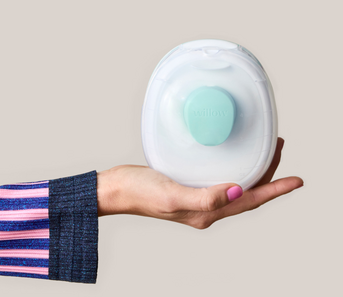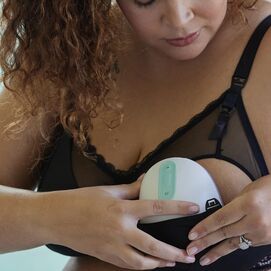As a new and expecting parent (or support person!) there’s so much information swirling around in the early, sleep deprived hours and days post-birth that breastfeeding and everything that goes with it: your first attempt at latching, positioning your breast, getting comfortable and being confident in the process can all lead to a lot of, “Am I doing this, right?” Whether you choose to breastfeed, exclusively pump or a combination of both we’re here to advocate for you and support you every step of the way. You got this, mama.
First Things First: The Benefits of Keeping a Schedule
Newborns are still so young and fresh, it’s not realistic for them to feed on any type of feeding schedule—it’s best to feed them on demand, when they cue that they are seeking milk or comfort. Baby hunger cues look like hands to mouth, licking, rooting, and eventually crying if these first several cues are not responded to quickly.
LC Tip: If you choose to exclusively breastfeed, you can start trying to implement a feeding schedule once your baby reaches the age of two months. If you decide to exclusively pump, you should set a pumping schedule immediately. Typically, this means pumping every 2-3 hours for 15 to 30 minutes for newborns. As your baby gets older you may be able to decrease the number of pumping sessions you have in a day, depending on your milk supply.
Simplify Your Early Days: How to Track Your Baby’s Feeding Schedule
No matter how you choose to nourish your baby, keeping a schedule will help keep you feeling confident, on track, and ensure you’re keeping your milk supply whether you’re pumping or breastfeeding. Remember, it’s all about supply and demand.
One note: Your feeding schedule should not feel like added work or stress—it’s to help you start a list of how your baby is feeding and to help you stay organized during long days and nights. Some of the benefits of keeping a schedule include:
Simplified planning: Scheduling your feedings makes it easy to stay on track, and maintain your pumping sessions when you’re away from your baby.
Simplified milk production tracking: If you begin to struggle at any time with pumping or breastfeeding, having a written overview of your baby’s feeding habits is the perfect thing to share with a lactation consultant. If you feel like you’re having trouble, reach out to one—they can help!
Increased volume per session: If you choose to pump exclusively, you’ll want to ensure you’re pumping as though your baby was on-demand breastfeeding. A schedule helps simulate a breastfeeding pattern and increases the volume you receive per session.
Consistent levels of milk each day: A schedule helps your body acclimate to pumping or breastfeeding and ensures you produce a consistent amount of milk each day.
What Are the Benefits of Breastfeeding and Pumping?
The Benefits of Breastfeeding
Some people choose to exclusively breastfeed their babies after birth. This means feeding your baby from the breast only until it’s time to wean. Some of the benefits of breastfeeding your little one include:
-
Bonding experience between you and your baby. Breastfeeding releases oxytocin and prolactin which are natural stress relief hormones and are said to help mom and baby feel more bonded.
-
Breast milk is a virus & bacteria fighter. Your breastmilk is loaded with antibodies that help fight off viruses and bacteria during those critical early days and months—especially the first milk, colostrum which is loaded with immunoglobulin A (IgA).
-
Health benefits for your baby. Studies have shown that babies who are breastfed have lower risks of ear infections, asthma, Type 2 diabetes and respiratory infections.
-
Health benefits for mom. The CDC states that breastfeeding can help lower a mother’s risk of high blood pressure, type 2 diabetes, ovarian cancer and breast cancer.
The Benefits of Pumping
Exclusively pumping allows you to take advantage of many of the benefits of breastfeeding such as lower health risks. By using a breast pump to express your milk and a bottle to feed your baby, you’ll experience many other benefits such as:
-
Shared feeding times. Many moms enjoy pumping as it allows their partner to help with feeding the baby. This is a great way to get some much-needed rest at night.
-
Increased milk supply. Pumping breast milk often throughout the day can increase your milk supply. It’s an easy way to build a milk stash for when you must travel or feed on-the-go.
-
Easy tracking of milk supply. Want to know how much milk you’re expressing for your baby? Pumping makes it easy to track how many ounces you pump in a day. If you need more, you can increase your pumping sessions.
-
More control over feeding times. Older babies over 2 months old can benefit from a feeding schedule. Pumping gives you more control, allowing you to choose when to feed your baby.
-
The ability to return to work. If you’re a mom who wants to return to work, pumping can help. Pumping allows you to store milk on a rolling basis to save for your baby’s caregiver.
Many moms choose to pump due to medical conditions that prevent their babies from breastfeeding such as latch concerns. Babies who are slower to return to birth weight in the early days may benefit from direct breastfeeding and additional pumped breast milk until they reach their birth weight. Pumping allows you and your baby to receive the benefits of breastmilk without requiring your baby to nurse.
What Are Some of Challenges You Can Expect?
We know that both breastfeeding and pumping can be hard at times. And although there’s nothing quite like caring for your baby, feeding can come with its challenges.
Breastfeeding
It’s common to hear all about the benefits of breastfeeding. The disadvantages? Not so much. And when you’re trying to decide which method is best, you must know what to expect. Some of the disadvantages of breastfeeding include:
More feeding sessions: Breastfed babies may feed more often depending on your milk supply and their age. This can be frustrating, especially if your baby needs to eat every hour or so.
Milk tracking: Breastfeeding makes it difficult to track how much milk you’re making. This can leave you concerned about whether or not your baby is getting what they need.
Full feeding responsibility is on you: Breastfeeding your baby means the responsibility of feeding sessions will fall on you, mama. This can be a challenge, especially as exhaustion sets in.
Discomfort: Breastfeeding can be painful and uncomfortable, until a strong latch is established.
Less flexibility: If you choose not to pump at all, you may not be able to return to work or travel until you decide to wean your baby.
Trouble producing enough breastmilk?
Your milk supply can be low for a variety of reasons, including the types of food you eat. To make sure you have balanced milk production, the first step is to pump and feed on a regular basis. Have questions on how to schedule your pumping times? Visit our article on pumping schedules to learn more.
Pumping
Exclusively pumping can reward you with the benefits of breast milk and additional flexibility. Yet, there are some disadvantages to pumping, including:
Additional expense: You’ll need to purchase additional supplies such as a breast pump, milk storage bags, storage containers, flanges and other tools.
Cleaning and maintenance: After every pumping session, you’ll need to take careful care of your pump. For example, you’ll need to clean the flanges to ensure bacteria stays far away from your baby’s milk. This can take time, which is hard to come by with a baby to care for.
Time-consuming: You’ll need to spend dedicated time pumping to ensure you have enough milk to feed your baby. It’s common for new moms to have to pump every 2-3 hours or more, depending on their baby’s needs.
Bringing your pumping supplies everywhere you go: If you return to work or have days where you need to run errands, you’ll need to bring your pumping supplies with you. Depending on the pump you choose, this can be inconvenient.
Trouble pumping enough for the day?
It's not uncommon for pumps to be less efficient than breastfeeding. Because your baby feeds on a supply and demand basis, they stop feeding when they are full. Pumps do not have the same internal signal, so it may take some practice learning how long you need to pump to fully empty your breasts.
Willow 360™ Wearable Breast Pump
Willow 360™ Wearable Breast Pump
Willow 360 is designed with a zero-gravity latch to give you 360° of leak-proof mobility. It's the hands-free breast pump that changed the game.
Willow Go™ Wearable Breast Pump
Willow Go™ Wearable Breast Pump
With hospital-grade suction and a 100% comfort rating, Willow Go pumps quietly and discreetly (no dangling tubes, bottles, or external motors) so you can do it all.
To Pump or Breastfeed: What is Best for You & Your Baby?
Should you choose to exclusively pump or breastfeed your baby? Whatever works best for you and your baby is the right choice. You know your baby and your needs best. It’s also a great idea to speak with your baby’s pediatrician or your doctor about your concerns. They may be able to provide support or get you in touch with a lactation specialist.
This article was written in partnership with our International Board Certified Lactation Consultant, Wendy Wright, who loves working side by side with moms and babies to find that secret sauce! She’s also a mother of two and the Mom Experience Lead at Willow Pump.















